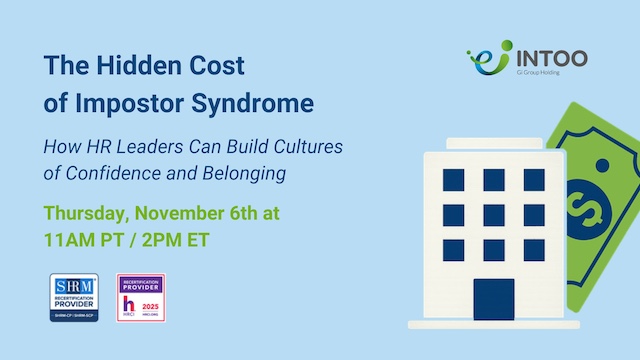A culture of mobility can enable employees to grow within your organization, building engagement and loyalty. But how do thriving organizations build a culture of mobility? In our webinar, INTOO career coach Lisa Nichols walked through the steps necessary to create an environment where employees can envision themselves developing their careers with your organization.
Click here to watch the webinar!
What is a Culture of Mobility?
A culture of mobility exists when organizational leaders encourage internal career moves that allow for equal opportunities and growth for everyone in the workforce across the organization.
How to Build a Culture of Mobility
Start with the interview
A culture of mobility should be instilled from the first communication with a potential employee. Candidates want to know that opportunities will be available to them beyond the role they are interviewing for. They have their own goals and want to know whether they will be supported in meeting them in order to continue to develop and grow professionally.
To achieve this support, the interviewer should be thinking about the long-term potential of the candidate. Communicating to them that you are interested in their potential beyond this one particular job function will help them to see your organization as one that cares about their future.
Make internal opportunities accessible to current employees
Have an easy way for employees to be notified of or to be able to view internal opportunities. Make sure they understand the process for applying for these roles. And then ensure that such movement is supported throughout the organization.
Connect your employees’ roles with purpose
Employees want to know that their work is contributing to a greater purpose. Make sure that you are transparent about the effects their work has on the success of the organization, and how it benefits the company’s mission. Managers should frequently reinforce the value of their team members’ contributions.
Recognize your employees for the whole humans they are
Your employees are not their job functions. By seeing beyond the specific responsibilities of their roles, you can see what else your team members have to offer the organization and their potential for growth. Get to know their skills, experience, background, and personality to see how, combined, they may make them qualified for other opportunities, whether currently or in the future. Assessments can help with this effort.
Click here to watch the webinar!
Getting Management on Board with Internal Mobility
Negative consequences of talent hoarding
Some managers may resist a culture of mobility because they worry about losing their best employees. However, the very employees they are hoarding may leave the organization if they aren’t allowed to grow within it. Other consequences of talent hoarding include lack of motivation, decreased morale, employees feeling undervalued, and higher turnover.
As you can see, the risks of holding on to employees too tightly are greater than any supposed benefit. In addition, you may assume increased talent acquisition costs and damage to the employer brand.
Overcoming managers’ resistance to internal mobility
When all of your managers consistently support the growth and development of their employees, they also reap the benefits when a team member moves to another role or department. This is because the culture of mobility creates a pipeline of internal talent to draw from. These managers should also be recognized and celebrated for supporting and developing their employees, as their team members’ advancement and internal movement strengthens the cohesion of the whole organization.
How to Adapt to an Internal Mobility Mindset
In order to have an internal mobility mindset, you’ll need to incorporate strategies that foster growth in all areas of the organization.
When hiring: Ensure that you are offering competitive pay to your internal candidates, just as you would offer an external candidate. Reevaluate your job descriptions so that you aren’t unintentionally narrowing your talent pool by including too many requirements. By loosening the requirements, you may find internal candidates you may have otherwise screened out who could bring beneficial skills and traits to a role. Once you’ve hired someone, create a career roadmap with them during the onboarding process so that the employee knows you can see their potential.
During the employee lifecycle: Continually express appreciation for employees’ contributions in a meaningful way. Invest in professional development, upskilling and training opportunities. Provide career and/or executive coaching for your employees so that they feel that their individual goals are being supported and that you’re invested in them advancing in their careers with you. Share stories of success resulting from internal mobility and growth so that employees see what’s possible and are encouraged to take action to further their development.
 Benefits of a Culture of Mobility
Benefits of a Culture of Mobility
When internal mobility is not only accepted but also supported and encouraged, employees are happier. Happy employees are more engaged and productive. They also tend to be more loyal, acting as ambassadors for your brand, spreading positive messaging about you as an employer. They’re more committed to your mission. And throughout the organization, there’s a greater sense of purpose and stronger team cohesion. This type of unity is particularly important now as an increasing number of teams are separated geographically and work remotely.
With greater retention comes lower onboarding costs. In addition, internal candidates are typically able to onboard for a new role and ramp up productivity than external candidates.
As you can see, an organization is stronger when each team member is positioned for individual growth and success. Helping all team members understand the benefits of a culture of mobility can unify them in efforts that will help both individuals and the company as a whole grow.
Click here to watch the webinar!
Need help building a culture of mobility at your organization? Contact us to learn how INTOO Career Development can help.
 INTOO career coach Lisa Nichols
INTOO career coach Lisa Nichols
Lisa Nichols is a career and leadership consultant who partners with executives to create career advancement opportunities and cultivate high-performing, supportive, human-centered teams. She has over 14 years of experience providing practical tools and insight to those in career transitions, working primarily with senior executives across diverse industries to position them for their next career move.INTOO’s coaches help employees in every stage of their career develop strategies to meet their goals, while employers reap the benefits of increased engagement, productivity, and retention. Learn more about how our career development programs can benefit your company.JTNDaWZyYW1lJTIwc3JjJTNEJTIyaHR0cHMlM0ElMkYlMkZyZXNvdXJjZXMuaW50b28uY29tJTJGaHVic0Zyb250JTJGZW1iZWRfY3RhJTJGNDcyNzA3JTIyJTIwc2Nyb2xsJTNEJTIybm9uZSUyMiUyMGJvcmRlciUzRCUyMjAlMjIlMjBmcmFtZWJvcmRlciUzRCUyMjAlMjIlMjB3aWR0aCUzRCUyMjI1MCUyMiUyMGhlaWdodCUzRCUyMjMzMCUyMiUzRSUzQyUyRmlmcmFtZSUzRQ==
Robyn Kern is a seasoned business writer who has written in the HR, education, technology, and nonprofit spaces. She writes about topics including outplacement, layoffs, career development, internal mobility, candidate experience, succession planning, talent acquisition, and more, with the goal of surfacing workforce trends and educating the HR community on these key topics. Her work has been featured on hrforhr.org and trainingindustry.com.












